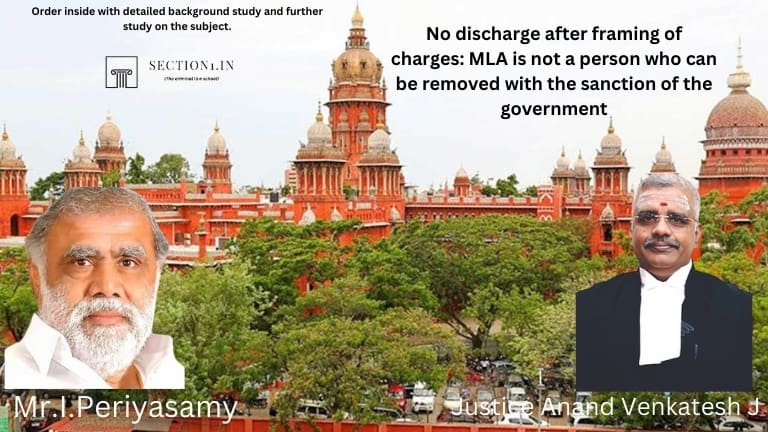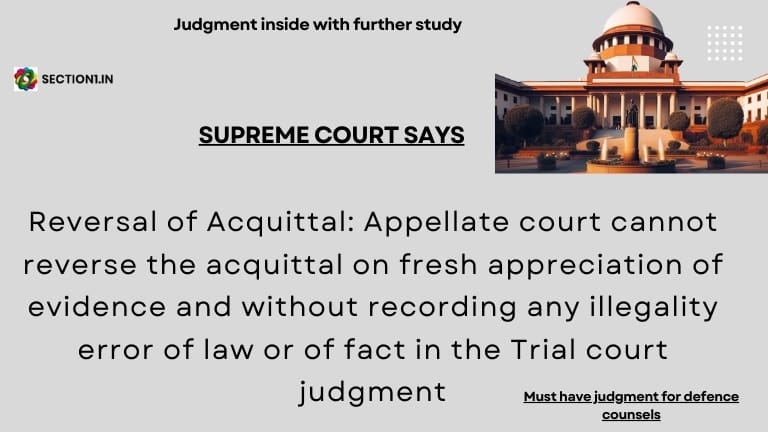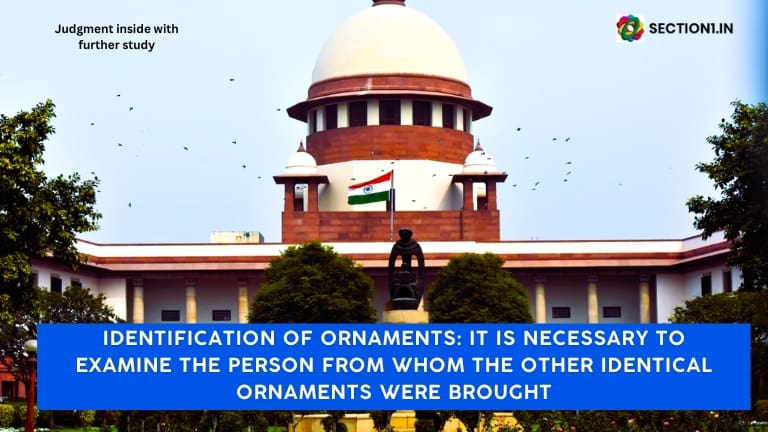Appellants convicted for the offence of murder
1. The appellants herein, namely, Babu Sahebagouda Rudragoudar(A-1), Alagond Sahebagouda Rudragoudar(A-2) and Mudakappa @ Gadegappa Rudragoudar(A-3) along with Sahebagouda Gadageppa Rudragoudar(A-4), Basappa Avvanna @ Huvanna Giradi @ Chigari (A-5) and Basappa Dundappa @ Dondiba Hanjagi (A-6) were subjected to trial in Sessions Case No. 28 of 2002 in the Court of the learned Fast Track Court I, Bijapur for charges pertaining to offences punishable under Sections 143, 147, 148, 506(2) and Section 302 read with Section 149 of the Indian Penal Code, 1860 (hereinafter being referred to as ‘IPC’).
Trial court acquitted a1, a2 and a3 but convicted a4, a5 and a6
3. The learned trial Court proceeded to discard the prosecution story and acquitted the accused appellants(A-1, A-2 and A-3) along with A-4, A-5 and A-6 vide judgment dated 23rd July, 2005.
Hon’ble High Court of Karnataka reversed the acquittal and further confirmed other accused conviction
4. The State of Karnataka challenged the said judgment recording acquittal of A-1 to A-6 by filing Criminal Appeal No. 2215/2005 before the High Court of Karnataka. The Division Bench of High Court vide its judgment dated 14th September, 2009 proceeded to allow the appeal; reversed the acquittal of A-1, A-2 and A-3 and convicted these accused for the offence punishable under Section 302 read with Section 34 IPC and sentenced them to undergo imprisonment for life and to pay a fine of Rs. 50,000/- each within a period of six months and in default, to further undergo imprisonment for two years. The appeal as against A-5 and A-6 was dismissed, while appeal qua A-4 stood abated on account of his death. Out of the fine amount to be realised, a sum of Rs. 10,000/- was ordered to be paid to the State Government and the balance amount of Rs. 1,40,000/- was ordered to be paid to the complainant(PW-1).
5. The judgment dated 14th September, 2009 rendered by the learned Division Bench of the High Court reversing the acquittal of the accused appellants and convicting and sentencing them as above is assailed in the present appeal.
Discussion and Conclusion
36. First of all, we would like to reiterate the principles laid down by this Court governing the scope of interference by the High Court in an appeal filed by the State for challenging acquittal of the accused recorded by the trial Court.
Hon’ble Supreme Court has discussed the following judgments
- Rajesh Prasad vs. State of Bihar [(2022) 3 SCC 471 – para.29] – legal position covering the field]
- H.D. Sundara & Ors. v. State of Karnataka – [(2023) 9 SCC 581 – para.8.1 to 8.5] – principles governing the exercise of appellate jurisdiction while dealing with an appeal against acquittal under Section 378 of CrPC.
Four principles to reverse the acquittal are explained
39. Thus, it is beyond the pale of doubt that the scope of interference by an appellate Court for reversing the judgment of acquittal recorded by the trial Court in favour of the accused has to be exercised within the four corners of the following principles:-
(a) That the judgment of acquittal suffers from patent perversity;
(b) That the same is based on a misreading/omission to consider material evidence on record;
(c) That no two reasonable views are possible and only the view consistent with the guilt of the accused is possible from the evidence available on record.
Findings are necessary to reverse the acquittal
40. The appellate Court, in order to interfere with the judgment of acquittal would have to record pertinent findings on the above factors if it is inclined to reverse the judgment of acquittal rendered by the trial Court.
Hon’ble High Court did not follow the settled principles in reversing the acquittal
41. In light of the above legal principles, if we go through the impugned judgment, we find that none of these essential mandates governing an appeal against acquittal were adverted to by learned Division Bench of the High Court which proceeded to virtually decide the appeal as a first Court on independent appreciation of evidence and recorded its own findings to hold the accused appellants(A-1, A-2 and A-3) guilty of the charge under Section 302 read with Section 34 IPC and sentenced them to imprisonment for life.
42. Thus, on the face of record, the judgment of the High Court causing interference with the acquittal of the accused appellants as recorded by the trial Court is contrary to the principles established by law.
Though many were present except the deceased none other received a single injury in the incident
44. The place of occurrence is admittedly at a distance of 10 kms from Police Station Tikota. The complainant(PW-1), father of the deceased Malagounda claiming to be an eye witness of the incident deposed that he lodged a complaint(Exhibit P-1) at the police station at 4 am, which resulted into registration of FIR(Exhibit P[1]10). It was alleged in the report that the complainant along with PW-2, PW-3, PW-4 and PW-5(servants, who had accompanied the deceased Malagounda to erect a bund in their land) witnessed the incident wherein, the assailants including the appellants herein, assaulted and killed the deceased by inflicting injuries with sharp weapons. It may be noted that even though the complainant(PW[1]1), the deceased and the labourers were all going together and the assailants were six in number, none other than the deceased Malagounda received a single injury in the incident.
PW-1 who witnessed the incident hid in the bushes and after the incident was over PW-1 reached his home and informed the incident to the other persons and to the police
46. The complainant(PW-1) stated in his evidence that he saw the brutal assault launched by the appellants and A-4(Sahebagouda) on his son Malagounda which took place at 4.00 pm or 5.00 pm in the evening of 19th September, 2001. While the incident was going on, he hid amongst the bushes so as to avoid being harmed by the assailants. The complainant did not state anything about the accused going away from the crime scene after the incident. However, he claimed that he returned back to his house just after sunset. The incident took place in the month of September and thus, it can be presumed that sunset must have occurred around 6:15 to 6.30 pm. The complainant stated that on reaching home, he divulged about the incident to his family members and soon thereafter, he and his cousins (as per his version in examination[1]in-chief) and his sons Shivanagouda and Banagouda(as per cross- examination) went to the Police Station Tikota and informed the police about the incident.
In natural course witnesses were bound to inform the incident to the police and their statements would have mandatorily been entered in the daily dairy which was not brought on record in this case creating doubt
47. Apparently, thus, the close relatives of the deceased had gone to the police station in the late hours of 19th September itself. If this version was true then, in natural course, these persons were bound to divulge about the incident to the police and their statement/s which would presumably be about an incident of the homicidal death would have mandatorily been entered in the Daily Dairy of the police station if not treated to be the FIR. However, the Daily Diary or the Roznamcha entry of the police station corresponding to the so called visit by the relatives of the deceased to the police station was not brought on record which creates a grave doubt on the genuineness of the FIR(Exhibit P-10). The complainant(PW-1) admitted in cross examination that the Poujadar came to his house and he narrated the incident to the officer who scribed the same and thereafter, the complainant appended his signatures on the writing made by the Poujadar. However, ASI Tikota Police Station(PW-18) testified on oath that complainant(PW-1) came to the police station and submitted a written report which was taken as the complaint of the incident. He did not state anything about any complaint being recorded at the house of the complainant prior to lodging of the report. Thus, there is a grave contradiction on this important aspect as to whether the report was submitted by the complainant(PW-1) in the form of a written complaint or whether the oral statement of complainant(PW-1) was recorded by the police officials at his home leading to the registration of FIR(Exhibit P-10). The non[1]production of the Daily Dairy maintained at the police station assumes great significance in the backdrop of these facts. Apparently thus, the FIR(Exhibit P-10) is a post investigation document and does not inspire confidence.
P.W-1 was an eye-witness to the incident is totally contradicted by P.W-6
49. A very important fact which is evident from the evidence of Basagonda(PW-6) who claimed to be an eye witness of the incident is that he did not state about the presence of the complainant(PW – 1) at the place of incident while the victim was being assaulted. PW-6 stated that he returned to his house at about 5.00 pm or 6.00 pm and then he informed the family members, i.e., Paragouda, Shankargouda and Chanagouda(PW-1). Thus, the case set up by prosecution that complainant, Chanagouda(PW-1) was an eye-witness to the incident, is totally contradicted by evidence of PW-6 who categorically stated that it was he who had informed the family members, the informant Chanagouda (PW-1) being one of them, about the incident at 6.00 or 7.00 pm and that they responded saying that they would be going to the police station for filing a report.
It is clear that the complainant party created eye-witnesses to the incident and suppressed the true genesis of the occurrence
53. Thus, there is no logical explanation for the presence of the deceased and the servants in their field on the date and time of the incident. It seems that not only did the complainant party create eye witnesses of the incident but has also suppressed the true genesis of the occurrence.
Motive is a double-edged weapon
55. It has been laid down by this Court in a catena of decisions that motive acts as a double-edged sword. Hence, the very fact that members of the prosecution party were arraigned as accused in the murder of Sangound, son of A-4, this could also have been the motive for the prosecution witness to rope in the accused appellants for the murder of Malagounda.
Requirement under the law to prove a disclosure statement is explained
58. We would now discuss about the requirement under law so as to prove a disclosure statement recorded under Section 27 of the Indian Evidence Act, 1872(hereinafter being referred to as ‘Evidence Act’) and the discoveries made in furtherance thereof.
A confession statement is nothing but a memorandum reduced in writing during interrogation which is inadmissible except any discovery
59. The statement of an accused recorded by a police officer under Section 27 of the Evidence Act is basically a memorandum of confession of the accused recorded by the Investigating Officer during interrogation which has been taken down in writing. The confessional part of such statement is inadmissible and only the part which distinctly leads to discovery of fact is admissible in evidence as laid down by this Court in the case of State of Uttar Pradesh v. Deoman Upadhyaya [AIR 1960 SC 1125].
IO must narrate the conversation of the interrogation in the witness box
60. Thus, when the Investigating Officer steps into the witness box for proving such disclosure statement, he would be required to narrate what the accused stated to him. The Investigating Officer essentially testifies about the conversation held between himself and the accused which has been taken down into writing leading to the discovery of incriminating fact(s).
Section 60 Evidence Act
61. As per Section 60 of the Evidence Act, oral evidence in all cases must be direct. The section leaves no ambiguity and mandates that no secondary/hearsay evidence can be given in case of oral evidence, except for the circumstances enumerated in the section. In case of a person who asserts to have heard a fact, only his evidence must be given in respect of the same.
Judgments on proving disclosure statement
62. The manner of proving the disclosure statement under Section 27 of the Evidence Act has been the subject matter of consideration by this Court in various judgments, some of which are being referred to below.
Mohd. Abdul Hafeez v. State of Andhra Pradesh [(1983) 1 SCC 143 – para.5)
Subramanya vs. State of Karnataka (2022 SCC Online SC 1400 para. 82 to 84)
Mere exhibiting the memorandum prepared by IO is not proof of its contents
65. Similar view was taken by this Court in the case of Ramanand @ Nandlal Bharti v. State of Uttar Pradesh6, wherein this Court held that mere exhibiting of memorandum prepared by the Investigating Officer during investigation cannot tantamount to proof of its contents. While testifying on oath, the Investigating Officer would be required to narrate the sequence of events which transpired leading to the recording of the disclosure statement.
Since I.O did not give any description of the conversation while recording disclosure statements then those statements cannot be read in evidence
66. If we peruse the extracted part of the evidence of the Investigating Officer(PW-27)(reproduced supra), in the backdrop of the above exposition of law laid down by this Court, the interrogation memos of the accused A-2(Exhibit P-15) and A-1 (Exhibit P-16), it is clear that the Investigating Officer(PW-27) gave no description at all of the conversation which had transpired between himself and the accused which was recorded in the disclosure statements. Thus, these disclosure statements cannot be read in evidence and the recoveries made in furtherance thereof are non est in the eyes of law.
Recovery from open spaces does not inspire confidence
69. Thus, we are of the firm opinion that neither the disclosure memos were proved in accordance with law nor the recovery of the weapons from open spaces inspire confidence and were wrongly relied upon by the High Court as incriminating material so as to reverse the finding of the acquittal recorded by the trial Court.
70. The evidence of seizure of weapons of the offence is not trustworthy and was rightly discarded by the trial Court.
Prosecution did not procure the serological opinion
71. In addition thereto, we may note that admittedly, the prosecution did not procure any serological opinion to establish blood group, if any, on the weapons so recovered. Thus, the recoveries are otherwise also meaningless and an exercise in futility.
FIR is a post-investigation document
72. Thus, neither the evidence of the eye witness is trustworthy nor did the prosecution provide any corroboration to the vacillating evidence of the so called eye witnesses. We have already held that the FIR(Exhibit P-10) was a post investigation document. Thus, the entire prosecution case comes under the shadow of doubt.
75. The appeal stands allowed accordingly
Party
BABU SAHEBAGOUDA RUDRAGOUDAR AND OTHERS …APPELLANT(S) VERSUS STATE OF KARNATAKA …RESPONDENT(S) – CRIMINAL APPEAL NO(S). 985 OF 2010 – 2024 INSC 320 – April 19, 2024
https://main.sci.gov.in/supremecourt/2010/8259/8259_2010_3_1502_52325_Judgement_19-Apr-2024.pdf
Further study
- Section 27 Evidence Act: Disclosure statements are per se not an individual evidence without corroboration to secure conviction
- Section 27 IEA: I.O did not narrate the exact words spoken by the accused while making a disclosure statement
- TEST IDENTIFICATION PARADE (TIP) IS NOT A SUBSTANTIVE PIECE OF EVIDENCE. IT IS HIT U/S 162 Cr.P.C
- STATEMENT u/s 164 Cr.P.C – NOT COMPULSORY TO RECORD.
- Court can grant pardon even for other offences (other than IPC) if connected with the present one







3 Comments
[…] Section 27 IEA: Mere exhibiting the disclosure statement to the IO is not sufficient but the IO must… […]
[…] Section 27 IEA: Mere exhibiting the disclosure statement to the IO is not sufficient but the IO must… […]
[…] Section 27 IEA: Mere exhibiting the disclosure statement to the IO is not sufficient but the IO must… […]